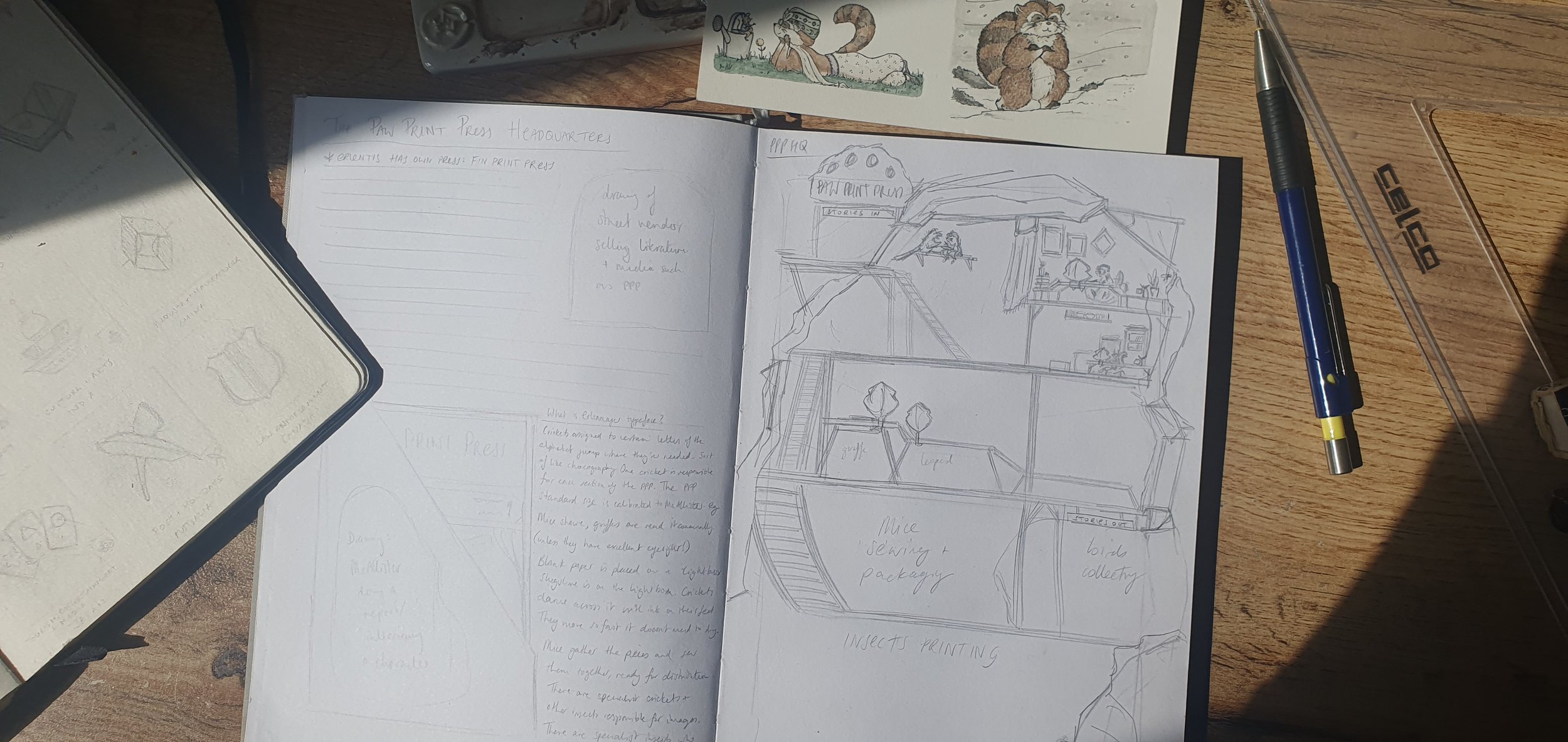Exploring Erlenmeyer…
From Avi ~ “The notes and sketches laid out here are extracts and examples of the many stories and facts that McAllister the raccoon has enthusiastically explained to me about the world that is to come. It is simply my understanding and portrayal of it, and we hope that in reading it, one might find a bit of peace and hope whilst living out the complexities of our own reality.”
Erlenmeyer is the name of the civilisation of animals that inhabits Earth in the distant future. At some point around the mid 21st century, humans make some significant alterations to their political structures; chiefly the installation of scientists and philosophers at top levels of international governments. This leads to great technological advancements, as well as a reassessment of planetary health and the state of the Earth in general. Human societies re-prioritise accordingly, and unilaterally invest their research and efforts into moving the population to space, which enables the Earth to replenish and its ecosystems to rebalance.
Human understanding of the nature of life and the universe is extremely limited, and to a certain extent restrained by the scientific, evidence-based theories that underpin it. All celestial objects (like planets) are watched over by an eternal deity or titan, and Earth’s is Gaia. Gaia’s responsibilities are not direct and she is not God-like, though she may be referred to by humans or animals as a goddess. She cares about the longevity of Earth, and she may plant seeds or ideas in the minds of living beings to carry out that duty of care.
Gaia is patient, purely intentioned and kind-hearted, but she is also curious and playful; she enjoys stimulation and is able to engage by manifesting herself in a form that can be interactive. Gaia was intrigued by the dinosaurs, saddened by their fall, and now is delighted by the humans. However, being duty-bound to preserve Earth, Gaia steps in to facilitate their safe passage to the stars.
With humans gone, and the Earth on the mend, Gaia amuses herself by recruiting a raccoon to help her bestow sentience on a select party of animals, and guide them through portals to the future Earth which is lush and fully recovered. This party consists of 12 animals, 4 from land, 4 from air and 4 from sea. Each one will establish a city in its local surroundings, aided by the animals in proximity to it, as sentience is transferable. These leader animals are known as Consuls, and their time in this position extends only to the limit of their natural life span, by which time another of their species is chosen to learn the ropes and take charge.
The map of the Lands of Erlenmeyer shows the locations of the 12 cities. Each city evolves a different specialisation around an aspect of their collective society, and provides the base where the research into their respective fields is carried out. Each city is represented by an emblem that depicts this focus, and all cities share their progress with one another to advance their society as a whole.
The biggest city is actually known as Erlenmeyer, and is located in Northern Italy. It is run by an owl called Consul Amber, and she lives and works at Erlenmeyer’s headquarters - The Philosopher’s Den. Consul Amber is responsible for the planning and structure of education and social welfare, which is why The Philosopher’s Den has many rooms and spaces for sitting, talking and writing.
All sorts of animals live in all the different cities, and there is much movement in between them, whether the citizen is a bird, a mammal or an insect. Any city that is coastal has a water-based twin hub for sentient oceanic dwellers. The cities accommodate the habitat and lifestyles of all inhabitants, some living inside trees, or up in tree-houses, some have made homes in cliffs or carved out boulders, some have burrowed underground and created subterranean network-like suburbs. Individual burrows link up together via communal caverns, often used as marketplaces for trade, or learning centres, or creches for baby animals. McAllister’s House is an example of a burrow connected by an archive room to his neighbour’s house (an arctic fox). Together they are writing and illustrating the histories of Erlenmeyer, which McAllister teaches to adult animals at his local learning centre.
McAllister also runs the Erlenmeyer newspaper, The Paw Print Press. The press’s headquarters is cut into an enormous rock structure, and has several levels. The birds are the journalists, and fly out to cover the stories. These are written up by a team of land creatures, then printed (in squid ink!) by insects, bound by field-mice, and eventually distributed by air or land couriers.
The Paw Print Press keeps citizens up-to-date on important events in their city and across the lands of Erlenmeyer, as well as providing information on developments for their communication devices (E-Leefs, or for marine citizens Sea-Leefs). It also provides entertainment and education in the form of puzzles, cultural pieces and studies of human histories. The animals are aware of their existence, as before humans leave Earth they design solar-powered holographic media-storage devices to showcase their diverse cultural and intellectual achievements to whatever intelligent lifeform might come across them in future. This is why many of the design aspects of the animal cities reflect elements of human architecture, along with their hobbies and interests (music, dance, cultural celebrations and dress). The Garden Balconies is the city hub for Bristol and it references current Bristol architecture and businesses, the Ghibli film Princess Mononoke, as well as Aardman productions, Banksy and other artists.
This page will be added to as McAllister and Avi continue their discussions on the establishment of the Erlenmeyer world. Check back soon! Thank you!







